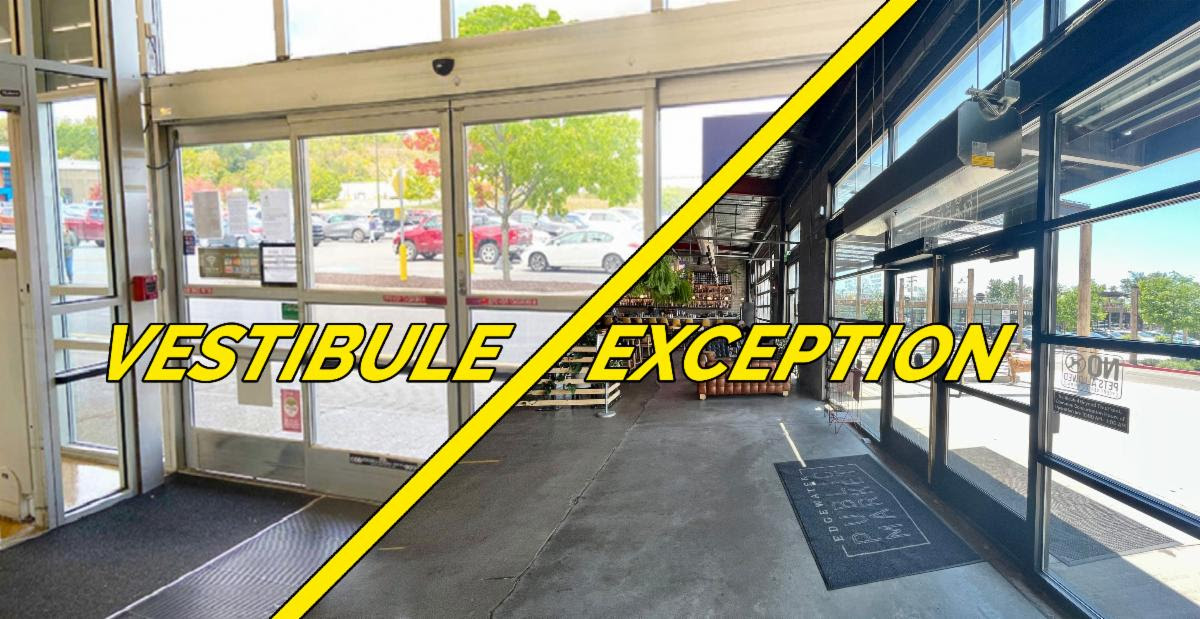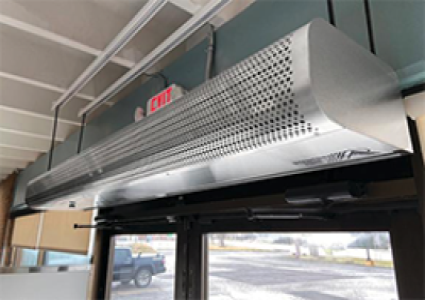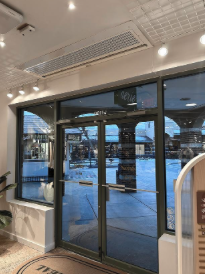
If you’ve walked through a set of doors in a grocery store, office or restaurant recently, there’s a good chance that you walked through two! How’s that? Because of Vestibules. A vestibule is a small room that separates the unconditioned exterior from the conditioned interior. The theory is that the vestibule acts as a buffer, separating outdoor from indoor climates.
The theory, however, doesn’t always make sense or consider that both doors are open at the same time, which can negate the effectiveness of said vestibule.
Vestibules have been in use for centuries as evidenced by ancient Greek and Roman architecture and while they still have their place, advancements in technology have created solutions that are more effective and cost a fraction of the price.

COMMON VESTIBULE CHALLENGES
- Both doors can be open at the same time, which negates the vestibule advantage by allowing the entrance of unconditioned outside air, flying insects, leaves, etc.
- Less potential for energy savings.
- Valuable floor space is consumed.
- More resources and time are required for construction.
- Higher maintenance and upkeep.
Enter the Vestibule Exception Air Curtain from Powered Aire. A properly installed air curtain can be more effective, more efficient and more price-friendly than a traditional vestibule. In this article, we’ll explore why. First, let’s discuss the Vestibule Exception Standard for Air Curtains.
What is the Vestibule Exception Standard? Since a 2019 standard update (ASHRAE 90.1 Vestibule Exception Standard), Air Curtains that:
- Are tested in accordance with the ANSI/AMCA 220 or ISO 27327-1
- Are installed and commissioned in accordance with the manufacturer’s instructions
- Have a jet velocity of not less than 6.6 feet per second (2.0 m/s) at 6 inches above the floor, along with a direction of not less than 20 degrees toward the opening.
- Include automatic controls that are provided and will operate the air curtain with the opening and closing of the door
- Are on self-closing doors in buildings in Climate Zones 0, 3, and 4 that comply with Section 10.4.5.
- Are on self-closing doors in buildings 15 stories or less in Climate Zones 5 thru 8 that comply with Section 10.4.
To have an easier time understanding whether an air curtain can replace a vestibule in your region, just shoot us a message and let the experts help!
info@poweredaire.com.

Assuming you do meet the requirements, let’s look at some core benefits of a Powered Aire air curtain in place of a vestibule.
- Save Space Without Compromising Performance - Vestibules require physical space—often several feet of additional construction—at building entrances. Where retail space is literally measured by the square foot, the space occupied by a vestibule can be put to better use. An air curtain mounts above the doorway and takes up virtually no floor space while delivering the same, if not better, environmental separation.
- Lower Construction and Maintenance Costs - There’s a lot that goes into building a vestibule. Planning, framing, wiring, and flooring, just to name a few. It’s an investment of time, capital and resources whereas air curtains require a fraction of the installation costs. They are considerably easier to maintain and can be placed into new builds or retrofits.
- Enhance Energy Efficiency Year-Round - It’s common that both sets of vestibule doors can be open at the same time—which allows for unwanted outside air, insects and exhaust to enter. Air curtains, with their consistent barrier of air, help maintain indoor air quality and reduce the load on a building’s HVAC system. This will ultimately result in energy savings that can be directly corelated to the air curtain.
- Improve Accessibility - One less door may not sound like a lot but for those in a wheelchair, pushing a stroller or requiring special assistance, it makes quite a difference. By eliminating the need for a second door, air curtains help improve and streamline accessibility.
- Support Health, Safety, and Sanitation Goals - As effective environmental separators, air curtains not only block outside air. They prevent the infiltration of airborne contaminants, flying pets, fumes, exhaust and other unwanted elements. This is crucial for restaurants, offices and other areas housing large numbers of people in a confined space.
- Aesthetically Flexible and Architecturally Friendly - Air curtains in place of vestibules offer an architecturally friendly solution as they preserve the aesthetics and open views in an entryway whereas vestibules can obstruct sight lines and flow. With air curtains, form doesn’t have to be sacrificed for function and the units can be customized to meet and match a building’s design aesthetics.

While vestibules have long been a standard feature in commercial building design, air curtains are quickly becoming the smarter choice for energy efficiency, space optimization, accessibility, and cost savings. Whether you’re designing a new facility or retrofitting an existing entrance, air curtains offer a modern, high-performance solution that keeps environments comfortable, clean, and compliant—without the bulk of a vestibule.
